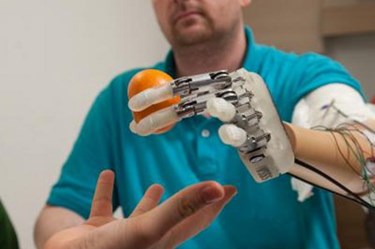Report Documents Success Of First Prosthetic Hand With Sense Of Touch
By Joel Lindsey

A team of European researchers has reported the successful use of a newly designed prosthetic hand capable of communicating a sense of touch to its wearers.
The study, published yesterday in the journal Science Translational Medicine, reports that 36-year-old amputee Dennis Aabo Sørensen was able to feel and distinguish between objects with his new prosthetic device, as well as make precise grasping maneuvers. During tests, Sørensen could accurately detect the difference between various objects such as cotton, plastic glasses, and wood while wearing both a blindfold and earplugs. He was also able to make finely tuned adjustments in grasping motions and firmness of grip.
“The sensory feedback was incredible,” Sørenson said in a press release. “I could feel things that I haven’t been able to feel in over nine years. When I held an object, I could fee if it was soft or hard, round or square.”
The prosthesis, the focus of the ongoing Lifehand 2 project, successfully created a bi-directional channel of communication between Sørenson’s brain and the nerves in his arm through a series of implanted sensors.
The electrodes connected to the ulnar nerve send information from the prosthetic pinky finger to the brain, while the ones implanted on the medial nerve communicate information gathered from the prosthetic thumb and index finger, CBS News reported. From there, the brain reacts, sending different commands to sensors on Sørenson’s stump. The sensors then turn that information into a digital message that’s sent to the prosthetic hand, which acts accordingly by adjusting its grip.
“This is the first time in neuroprosthetics that sensory feedback has been restored and used by an amputee in real-time to control an artificial limb,” said Silvestro Micera, one of the leading researchers on the Lifehand 2 project.
The project brought together scientists, developers, surgeons, and neurologists from France, Italy, the United Kingdom, and Denmark, according to the Los Angeles Times.
While Sørenson and members of the Lifehand 2 project are enthusiastic about the success of the prosthesis so far, the reality of a marketable prosthetic hand with a fully operational and acute sense of touch remains distant.
“The clinical study provides the first step towards a bionic hand, although a sensory-enhanced prosthetic is years away from being commercially available and the bionic hand of science fiction movies is even further away,” the team’s press release said. “The next step involves miniaturizing the sensory feedback electronics for a portable prosthetic. In addition, the scientists will fine-tune the sensory technology for better touch resolution and increased awareness about the angular movement of fingers.”
